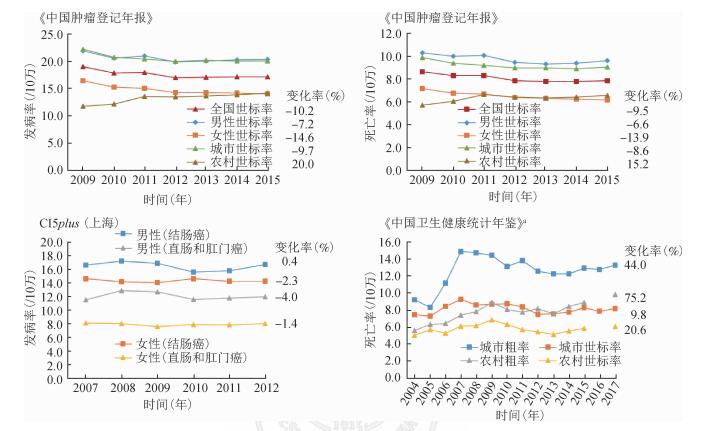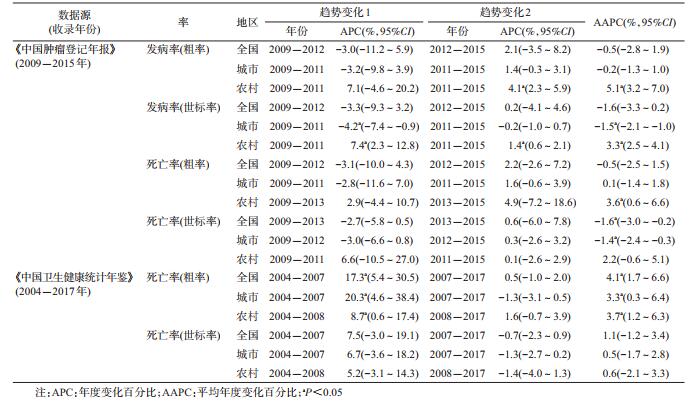文章信息
- 王红, 曹梦迪, 刘成成, 严鑫鑫, 黄慧瑶, 张玥, 陈宏达, 任建松, 李霓, 陈万青, 代敏, 石菊芳.
- Wang Hong, Cao Mengdi, Liu Chengcheng, Yan Xinxin, Huang Huiyao, Zhang Yue, Chen Hongda, Ren Jiansong, Li Ni, Chen Wanqing, Dai Min, Shi Jufang
- 中国人群结直肠癌疾病负担:近年是否有变?
- Disease burden of colorectal cancer in China: any changes in recent years?
- 中华流行病学杂志, 2020, 41(10): 1633-1642
- Chinese Journal of Epidemiology, 2020, 41(10): 1633-1642
- http://dx.doi.org/10.3760/cma.j.cn112338-20200306-00273
-
文章历史
收稿日期: 2020-03-06
2. 国家癌症中心/国家肿瘤临床医学研究中心/中国医学科学院北京协和医学院肿瘤医院药物临床试验研究中心, 北京 100021;
3. 首都医科大学附属北京妇产医院科技处, 北京 100026
2. Clinical Trials Center, National Cancer Center/National Clinical Research Center for Cancer/Cancer Hospital, Chinese Academy of Medical Sciences and Peking Union Medical College, Beijing 100021, China;
3. Beijing Obstetrics and Gynecology Hospital, Capital Medical University, Beijing 100026, China
结直肠癌是全球范围内严重危害人群健康的恶性肿瘤之一,GLOBOCAN 2018估计全球结直肠癌新发病例和死亡病例分别为185万和88万,其中我国分别各占28%[1]。最新中国肿瘤登记数据显示,2015年全国结直肠癌新发病例数为38.8万,死亡病例数为18.7万[2],其发病数和死亡数分别位列我国恶性肿瘤第3位和第5位[3]。张玥等[4]汇总整理国内外5个结直肠癌疾病负担数据源,2015年分析发表了20世纪70年代到该研究开展之时可获得的我国结直肠癌疾病负担的长期趋势数据及当时状况。2015年至今,5个数据源中有3个已有更新;作为广义疾病负担概念的经济负担方向,也有更多证据出现。本研究基于前期系统分析积累数据[4],对2015年后有更新的3个数据源进行了提炼分析,并扩大数据收集范围至之前未覆盖的相关权威数据源[5],同时增加结直肠癌经济负担相关文献数据。该研究结果预期可为了解我国结直肠癌疾病(包括经济)负担的最新动态,了解我国近年来人群干预项目的初步成效,以及未来开展结直肠癌筛查及相关防控提供较系统的参考信息。
资料与方法1.数据来源:本研究重点纳入前期张玥等[4]分析的5个结直肠癌疾病负担数据源中2015年至今有更新的3个数据源,并纳入另外3个数据源,包括2012-2018年《中国肿瘤登记年报》[6-12]、《中国死因监测数据集2017》[13]、2005-2018年《中国卫生健康统计年鉴》[14-27]、国际癌症研究署(IARC)网络数据库GLOBOCAN 2018[1]、五大洲癌症发病率(Cancer Incidence in Five Continents,CI5)(第Ⅹ卷、第Ⅺ卷和CI5plus)[28-30]和2017年全球疾病负担(Global Burden of Disease,GBD)[31],数据源基本概况参见前期文章[4-5]。此外,在作者团队前期系统分析1996-2015年结直肠癌经济负担基础上[32],采用文献法进行快速检索,用“结直肠癌”“经济负担”“费用”等关键词检索中国知网、万方数据知识服务平台,用“colorectal neoplasms”“health expenditures”“economic burden”等关键词检索PubMed,汇总2016-2019年的结直肠癌经济负担相关核心文献。
2.数据处理:摘录上述6个数据源资料中结直肠癌相关发病率(数)、死亡率(数)和患病率,包括全国总体、分城乡、分性别、分年龄别人群等细化数据,以及GBD2017发布的1990-2017年我国结直肠癌所致的伤残调整寿命年(DALY)、过早死亡损失寿命年(YLL)、伤残损失寿命年(YLD)和年龄别DALY率。根据世界人口标准[33]年龄构成计算发病率和死亡率的世标率。为方便不同数据源之间的比较,将GBD2017、《2018中国肿瘤登记年报》、CI5第Ⅺ卷和《中国死因监测数据集2017》的年龄组进行了统一整合。结合CI5第Ⅺ卷报道我国内地35个登记点的性别、年龄别发病率和人口数计算得到各登记点的结直肠癌发病数,再与人口数相除得到相应的合计结直肠癌发病粗率及分性别、年龄别、城乡的发病粗率,最终根据世界人口标准年龄构成计算了相应的世标率。其中城乡划分根据国家统计局行政区划原则,以地级以上城市为城市地区,县或县级市为农村地区。摘录《中国肿瘤登记年报》中结直肠癌的3个发病部位构成及CI5第Ⅺ卷中中国内地35个登记点人群结直肠癌13个细化发病部位构成,结直肠癌采用ICD-10编码。经济负担研究摘录纳入文献基本特征和结果(包括直接医疗费用和直接非医疗费用、间接费用)等信息,涉及费用数据均以我国医疗保健消费价格指数统一贴现至2018年。
3.统计学分析:分别整合CI5plus(以上海为例,2007-2012年)、《中国肿瘤登记年报》(2009-2015年)、《中国卫生健康统计年鉴》(2004-2017年)和GBD2017项目数据,分析结直肠癌发病率、死亡率和DALY的时间趋势。对《中国肿瘤登记年报》中的发病和死亡数据,以及《中国卫生健康统计年鉴》中的死亡数据,应用Joinpoint Trend Analysis Software 4.7.0.0软件进行时间趋势分析,不同时间段的年度变化百分比(APC)和平均年度变化百分比(AAPC)应用对数线性回归模型进行计算,检验水准α=0.05。采用GLOBOCN 2018在线平台摘录2018-2040年我国结直肠癌发病例数,预测我国结直肠癌疾病负担趋势。
结果1.疾病负担现状:GLOBOCAN 2018估计2018年中国结直肠癌发病率和死亡率分别为23.7/10万和10.9/10万。GBD显示2017年中国结直肠癌发病率和死亡率分别为19.6/10万和8.1/10万。《2018中国肿瘤登记年报》报告的2015年全国肿瘤登记地区的发病率为17.1/10万,男女性别比和城乡比分别为1.5和1.4;死亡率为7.9/10万,男女性别比和城乡比分别为1.6和1.4。CI5第Ⅺ卷显示2008-2012年全国内地35个肿瘤登记点的结直肠癌发病率为20.2/10万。《中国死因监测数据集2017》报告的2017年全国死亡率为6.9/10万。《2018中国卫生健康统计年鉴》报告的2017年城市和农村死亡率分别为8.2/10万和6.0/10万(表 1)。中国结直肠癌发病率在50岁开始明显上升,死亡率在60岁开始上升明显,不同数据源之间略有差异,但整体趋势一致(图 1)。

|
| 图 1 中国人群结直肠癌疾病负担的年龄别分布 |
2.近期时间趋势:《中国肿瘤登记年报》数据显示,2009-2015年中国结直肠癌发病率和死亡率均呈下降趋势,分别下降10.2%和9.5%;城市人群发病率和死亡率均呈下降趋势,分别下降9.7%和8.6%,而农村人群发病率和死亡率均呈上升趋势,增幅分别为20.0%和15.2%(图 2);Joinpoint分析细化趋势显示,2009-2015年中国城市和农村发病率世标率AAPC分别为-1.5%(P<0.05)和3.3%(P<0.05);全国死亡率世标率AAPC为-1.6%(P<0.05),城市为-1.4%(P<0.05),农村趋势无统计学意义(表 2)。CI5plus数据显示,2007-2012年上海市男性和女性的结肠癌及直肠和肛门癌的发病率比较平稳,变化率均≤4.0%(图 2)。《中国卫生健康统计年鉴》显示,2004-2017年中国城市和农村人群结直肠癌死亡率均呈上升趋势,增幅分别为9.8%和20.6%;Joinpoint分析细化趋势显示,2004-2017年中国人群死亡率世标率趋势无统计学意义(表 2)。

|
| 注:a《中国卫生健康统计年鉴》中报道的2016年有异常值,本研究将其作为缺失值处理 图 2 中国人群结直肠癌发病率与死亡率的时间趋势 |
3.发病部位构成:《中国肿瘤登记年报》中结直肠/肛门癌不同发病部位构成显示,2015年结肠癌(C18)、直肠癌(C19~C20)和肛门癌(C21)分别占49.6%、49.2%和1.2%,对应2009年占比分别为51.3%、47.6%和1.1%;2009-2015年结肠癌的比例有所降低(下降3.4%),而直肠癌和肛门癌的比例有所增加,增幅分别为3.4%和11.1%。分性别来看,男性直肠癌(≥49.9%)占比始终高于结肠癌(≤49.0%),女性则相反。分城市和农村来看,城市结肠癌(≥52.6%)占比始终高于直肠癌(≤46.4%),农村直肠癌(≥55.1%)占比始终高于结肠癌(≤43.2%)。CI5第Ⅺ卷(2008-2012年)收录结直肠癌13个发病部位构成显示,我国人群结肠癌以升结肠和乙状结肠及结肠重叠病变为主,细化构成比例见图 3。

|
| 注:CI5第XI卷收录了结直肠癌13个发病部位构成, 其中结肠癌(C18)细化为盲肠(C18.0)、阑尾(C18.1).升结肠(C18.2)、结肠右曲(C18.3)、横结肠(C18.4)、结肠左曲(C18.5).降结肠(C18.6).乙状结肠(C18.7).结肠重叠病变及其他(C18.8--9)9个部位, 直肠癌(C19 ~ C20)细化为直肠乙状结肠连接部(C19)和直肠(C20), 肛门癌(C21)细化为肛门(C21.0-2)和直肠肛门重叠病变(C21.8) 图 3 中国人群结直肠癌发病部位构成分析 |
4. DALY负担:中国结直肠癌DALYs负担从1990年的212.3万人年上升至2017年的425.4万人年。DALY率结果显示,我国人群结直肠癌DALY率从1990年的177.4/10万增至2017年的301.2/10万,上升趋势远高于全球;且男性上升趋势比女性更明显。从DALY内部构成来看,YLL占95%以上,但1990-2017年,YLD比重呈缓慢上升趋势,从2.1%增至5.0%。从年龄别来看,1990-2005年年龄别结直肠癌DALYs损失随时间呈峰值不断增大且峰值年龄逐渐后移,DALYs负担峰值1990年为60~64岁组25.4万人年,2005年为70~74岁组35.2万人年;到2010年,DALYs负担峰值前移至60~64岁组;2015-2017年峰值在60~69岁,55~59岁组出现明显下降。DALY率峰值在1990-2000年为75~79岁,2005-2017年峰值后移为80~84岁,2017年DALY率峰值为1 453.3/10万。见图 4。

|
| 图 4 中国人群结直肠癌所致DALY负担 |
5.未来预测:GLOBOCAN 2018将年龄别发病率和死亡率与人口增长相结合,对2018-2040年中国结直肠癌发病与死亡例数进行预测。2040年估计我国结直肠癌发病例数将达到895 146例,比2018年增加71.7%,其中≥70岁人群增幅(156.6%)远高于<70岁人群(18.4%);死亡例数将达到493 273例,较2018年增加99.3%,≥70岁人群增幅更为明显(158.9%),与发病例数相一致(图 5)。

|
| 图 5 基于GLOBOCAN的中国人群结直肠癌发病与死亡例数预测 |
6.经济负担分析:前期刘成成等[32]对1996-2015年纳入的24篇结直肠癌经济负担文献进行的系统综述结果显示,23篇基于个体的研究指标多为单一直接医疗费用,例均、次均和日均费用中位数分别是33 516、26 320和1 057元,20年间年均增长率分别是6.9%、3.7%和7.8%;例均费用中,东、中、西部地区依次降低。2016年至今共检出7篇结直肠癌经济负担相关文献[34-40],其中5篇个体研究中有2篇多中心大样本研究[35, 37]:1篇报道2002-2011年例均直接医疗费用为46 895元,年均增长率为9.2%[37];另1篇数据收集时间更新至2014年,提示结直肠癌患者确诊1年内的个人卫生支出费用为38 479元,占其家庭收入的59.9%,致使75.0%的家庭感到一定或较大的经济压力[35]。人群规模研究较少[39-40],1项研究提示,相比我国其他常见癌症,结直肠癌直接经济负担增长率最高(2011-2015年增长率为94.0%)[40]。更多信息见表 3。
本研究在2015年系统分析5个结直肠癌疾病负担数据源基础上[4],对2015年之后有更新的3个数据源,以及新扩充的另外3个数据源进行分析,同时增加经济负担相关数据,对我国结直肠癌疾病(包括经济)负担的现状及趋势进行了更新。目前我国结直肠癌疾病负担依然是男性高于女性,城市高于农村;从2009年起,我国结直肠癌的发病率和死亡率整体平稳中可能略有下降,但农村人群发病率有上升趋势;发病部位显示城乡差异显著。我国人群结直肠癌所致DALY和经济负担依然在持续增加。预测数据显示未来20年>70岁人群的疾病负担将持续加重。
本研究结果显示,近年来,我国结直肠癌疾病负担整体平稳中可能略有下降,与前期研究提示的上升趋势不同[4],分析原因,前期研究分析的是19世纪70年代到该研究开展之时可获得的我国结直肠癌发病的长期趋势,而本研究分析近年来的短期趋势,虽提示有所下降,但有可能属于短期正常波动;另外,本研究的趋势结果主要基于两个数据源:《中国肿瘤登记年报》和《中国卫生健康统计年鉴》,前者提示下降趋势,后者则无明显趋势,因此,此结论还需更多证据支持。分城乡来看,城市人群发病率和死亡率均呈下降趋势,但农村人群发病率呈上升趋势。结直肠癌在经济发达地区发病率较高,因此无论是历史数据还是现况数据,均显示我国城市人群结直肠癌的发病率高于农村人群[2, 4, 41]。但本研究发现近年来,发病率趋势在城乡之间的差异越来越明显,虽然农村人群发病率依然低于城市人群,但其增长幅度较高,已经有向城市人群发病率靠拢的趋势。推测原因,近年来我国城市化进程加快,农村地区居民的生活方式已逐渐转变,同时我国癌症筛查项目的开展对疾病发现也会造成一定影响。
从结直肠癌的发病部位来看,本研究显示,2009-2015年,我国人群结肠癌占全部结直肠肛门癌的比例有所降低,直肠癌有所增加。以往研究显示,我国人群结肠癌所占比例在1980-2009年之间呈上升趋势[42-43],与本研究提示的趋势不同,分析原因,一方面可能是短期波动,另一方面也提示近年来我国结直肠癌发病模式可能有所变化。研究表明,结肠癌和直肠癌的危险因素有所差异[44],我国人群近年来发病部位的变化可能与生活方式和环境因素变化有关,但目前相关研究较少,还需更多研究支持。分城乡来看,农村人群以直肠癌为主,城市人群以结肠癌为主,也提示社会经济和医疗技术对疾病发生发现的影响。从更细化的发病部位来看,结肠癌以升结肠和乙状结肠及其他结肠重叠病变为主,不同性别和城乡人群发病部位构成略有差异。
GBD2017数据显示,2017年我国结直肠癌所致DALY占全球结直肠癌所致DALY的22.4%,因此,从全球范围来看,我国人群结直肠癌疾病负担不容忽视。分析时间趋势发现,从1990年开始,我国人群结直肠癌所致DALY逐年增加,2017年相比1990年DALY数值已经翻倍;从DALY构成来看,YLD所占比重也在逐渐增加。分析原因,从2005年的农村癌症早诊早治项目开始,我国大肠癌筛查项目越来越多,覆盖范围越来越广,筛查能提早发现癌前病变和早期癌症,使得更多的早期病例得到了及时治疗,因此结直肠癌造成的健康生命年的损失有所增加,提示应关注癌症患者的生活质量。
结直肠癌经济负担相关文献汇总结果显示,我国结直肠癌经济负担研究人群层面数据匮乏;个体研究显示我国结直肠癌直接医疗费用呈增长趋势,可能与近年来癌症靶向治疗的普及、昂贵生物制剂应用等有关;同时结直肠癌经济负担存在地区差异,可能与我国不同地区经济发展水平及医疗卫生资源配置分布差异有关。总体来说,结直肠癌对我国人群造成的经济负担不容忽视,但目前缺乏全面评价的数据,期待未来有更多的人群层面研究,对结直肠癌的直接医疗费用、直接非医疗费用以及间接费用等进行综合评价。
本研究存在局限性。首先,疾病负担选取的不同资料数据源特点不同,其所收录的发病或死亡数据来源、人口资料等存在差异,可能对汇总分析结果有一定影响。其次,经济负担研究相关文献没有通过系统检索得到。再者,现有经济负担研究多局限于地区或个体层面,缺少多中心、大样本的数据,较难得出准确结论,故期待有更多人群规模的经济负担相关研究以进一步分析。
综上所述,我国结直肠癌疾病负担近年整体平稳中可能略有下降,农村的疾病负担上升应关注;与前期研究一致,城市和男性仍为防控重点;结肠部位的癌症占比在城市更高,提示社会经济和医疗技术对疾病发生发现有影响。此外,结直肠癌所致经济负担在持续上升。
利益冲突 所有作者均声明不存在利益冲突
| [1] |
Ferlay J, Ervik M, Lam F, et al. Global Cancer Observatory: Cancer Today[EB/OL]. Lyon, France: International Agency for Research on Cancer.[2020-01-14]. https://gco.iarc.fr/today.
|
| [2] |
吴春晓, 顾凯, 龚杨明, 等. 2015年中国结直肠癌发病和死亡情况分析[J]. 中国癌症杂志, 2020, 30(4): 241-245. Wu CX, Gu K, Gong YM, et al. Analysis of incidence and mortality of colorectal cancer in China, 2015[J]. China Oncol, 2020, 30(4): 241-245. DOI:10.19401/j.cnki.1007-3639.2020.04.001 |
| [3] |
郑荣寿, 孙可欣, 张思维, 等. 2015年中国恶性肿瘤流行情况分析[J]. 中华肿瘤杂志, 2019, 41(1): 19-28. Zheng RS, Sun KX, Zhang SW, et al. Report of cancer epidemiology in China, 2015[J]. Chin J Oncol, 2019, 41(1): 19-28. DOI:10.3760/cma.j.issn.0253-3766.2019.01.008 |
| [4] |
张玥, 石菊芳, 黄慧瑶, 等. 中国人群结直肠癌疾病负担分析[J]. 中华流行病学杂志, 2015, 36(7): 709-714. Zhang Y, Shi JF, Huang HY, et al. Burden of colorectal cancer in China[J]. Chin J Epidemiol, 2015, 36(7): 709-714. DOI:10.3760/cma.j.issn.0254-6450.2015.07.010 |
| [5] |
王乐, 张玥, 石菊芳, 等. 中国女性乳腺癌疾病负担分析[J]. 中华流行病学杂志, 2016, 37(7): 970-976. Wang L, Zhang Y, Shi JF, et al. Disease burden of famale breast cancer in China[J]. Chin J Epidemiol, 2016, 37(7): 970-976. DOI:10.3760/cma.j.issn.0254-6450.2016.07.013 |
| [6] |
赫捷, 陈万青. 2012中国肿瘤登记年报[M]. 北京: 军事医学科学出版社, 2012. He J, Chen WQ. 2012 Chinese cancer registry annual report[M]. Beijing: Military Medical Sciences Press, 2012. |
| [7] |
赫捷, 陈万青. 2013中国肿瘤登记年报[M]. 北京: 清华大学出版社, 2017. He J, Chen WQ. 2013 Chinese cancer registry annual report[M]. Beijing: Tsinghua University Press, 2017. |
| [8] |
赫捷, 陈万青. 2014中国肿瘤登记年报[M]. 北京: 清华大学出版社, 2017. He J, Chen WQ. 2014 Chinese cancer registry annual report[M]. Beijing: Tsinghua University Press, 2017. |
| [9] |
赫捷, 陈万青. 2015中国肿瘤登记年报[M]. 北京: 清华大学出版社, 2017. He J, Chen WQ. 2015 Chinese cancer registry annual report[M]. Beijing: Tsinghua University Press, 2017. |
| [10] |
赫捷, 陈万青. 2016中国肿瘤登记年报[M]. 北京: 清华大学出版社, 2017. He J, Chen WQ. 2016 Chinese cancer registry annual report[M]. Beijing: Tsinghua University Press, 2017. |
| [11] |
赫捷, 陈万青. 2017中国肿瘤登记年报[M]. 北京: 人民卫生出版社, 2018. He J, Chen WQ. 2017 Chinese cancer registry annual report[M]. Beijing: People's Medical Publishing House, 2018. |
| [12] |
赫捷, 陈万青. 2018中国肿瘤登记年报[M]. 北京: 人民卫生出版社, 2019. He J, Chen WQ. 2018 Chinese cancer registry annual report[M]. Beijing: People's Medical Publishing House, 2019. |
| [13] |
中国疾病预防控制中心慢性非传染性疾病预防控制中心, 国家卫生计生委统计信息中心. 中国死因监测数据集-2017[M]. 北京: 中国科学技术出版社, 2018. The Chinese Center for Chronic and Noncommunicable Disease Control and Prevention, Chinese Center for Disease Control and Prevention, Statistical Information Center of National Health and Family Planning Commission.. Monitoring datasets of national disease surveillance system 2017[M]. Beijing: China Science and Technology Press, 2018. |
| [14] |
中华人民共和国卫生部. 2005中国卫生统计年鉴[M]. 北京: 中国协和医科大学出版社, 2005. Ministry of Health of the People's Republic of China. 2005 China health statistics yearbook[M]. Beijing: Peking Union Medical College Press, 2005. |
| [15] |
中华人民共和国卫生部. 2006中国卫生统计年鉴[M]. 北京: 中国协和医科大学出版社, 2006. Ministry of Health of the People's Republic of China. 2006 China health statistics yearbook[M]. Beijing: Peking Union Medical College Press, 2006. |
| [16] |
中华人民共和国卫生部. 2007中国卫生统计年鉴[M]. 北京: 中国协和医科大学出版社, 2007. Ministry of Health of the People's Republic of China. 2007 China health statistics yearbook[M]. Beijing: Peking Union Medical College Press, 2007. |
| [17] |
中华人民共和国卫生部. 2008中国卫生统计年鉴[M]. 北京: 中国协和医科大学出版社, 2008. Ministry of Health of the People's Republic of China. 2008 China health statistics yearbook[M]. Beijing: Peking Union Medical College Press, 2008. |
| [18] |
中华人民共和国卫生部. 2009中国卫生统计年鉴[M]. 北京: 中国协和医科大学出版社, 2009. Ministry of Health of the People's Republic of China. 2009 China health statistics yearbook[M]. Beijing: Peking Union Medical College Press, 2009. |
| [19] |
中华人民共和国卫生部. 2010中国卫生统计年鉴[M]. 北京: 中国协和医科大学出版社, 2010. Ministry of Health of the People's Republic of China. 2010 China health statistics yearbook[M]. Beijing: Peking Union Medical College Press, 2010. |
| [20] |
中华人民共和国卫生部. 2011中国卫生统计年鉴[M]. 北京: 中国协和医科大学出版社, 2011. Ministry of Health of the People's Republic of China. 2011 China health statistics yearbook[M]. Beijing: Peking Union Medical College Press, 2011. |
| [21] |
中华人民共和国卫生部. 2012中国卫生统计年鉴[M]. 北京: 中国协和医科大学出版社, 2012. Ministry of Health of the People's Republic of China. 2012 China health statistics yearbook[M]. Beijing: Peking Union Medical College Press, 2012. |
| [22] |
国家卫生和计划生育委员会. 2013中国卫生和计划生育统计年鉴[M]. 北京: 中国协和医科大学出版社, 2013. National Health and Family Planning Commission. 2013 China health and family planning statistical yearbook[M]. Beijing: Peking Union Medical College Press, 2013. |
| [23] |
国家卫生和计划生育委员会. 2014中国卫生和计划生育统计年鉴[M]. 北京: 中国协和医科大学出版社, 2014. National Health and Family Planning Commission. 2014 China health and family planning statistical yearbook[M]. Beijing: Peking Union Medical College Press, 2014. |
| [24] |
国家卫生和计划生育委员会. 2015中国卫生和计划生育统计年鉴[M]. 北京: 中国协和医科大学出版社, 2015. National Health and Family Planning Commission. 2015 China health and family planning statistical yearbook[M]. Beijing: Peking Union Medical College Press, 2015. |
| [25] |
国家卫生和计划生育委员会. 2016中国卫生和计划生育统计年鉴[M]. 北京: 中国协和医科大学出版社, 2016. National Health and Family Planning Commission. 2016 China health and family planning statistical yearbook[M]. Beijing: Peking Union Medical College Press, 2016. |
| [26] |
国家卫生和计划生育委员会. 2017中国卫生和计划生育统计年鉴[M]. 北京: 中国协和医科大学出版社, 2017. National Health and Family Planning Commission. 2017 China health and family planning statistical yearbook[M]. Beijing: Peking Union Medical College Press, 2017. |
| [27] |
国家卫生健康委员会. 2018中国卫生健康统计年鉴[M]. 北京: 中国协和医科大学出版社, 2018. National Health Commission. 2018 China health statistics yearbook[M]. Beijing: Peking Union Medical College Press, 2018. |
| [28] |
Bray F, Colombet M, Mery L, et al. Cancer incidence in five continents, Vol. Ⅺ[EB/OL]. Lyon: International Agency for Research on Cancer.[2019-12-14].http://ci5.iarc.fr.
|
| [29] |
Forman D, Bray F, Brewster DH, et al. Cancer incidence in five continents, Vol. Ⅹ[EB/OL]. Lyon: IARC Scientific Publications.[2019-12-14]. https://ci5.iarc.fr/CI5-X/Default.aspx.
|
| [30] |
Ferlay J, Colombet M, Bray F. Cancer Incidence in Five Continents, CI5plus: IARC CancerBase No.9[EB/OL]. Lyon: International Agency for Research on Cancer.[2020-03-05]. http://ghdx.healthdata.org/gbd-2017.
|
| [31] |
Institute for Health Metrics and Evaluation. Global burden of disease project[EB/OL].[2020-03-05]. http://ghdx.healthdata.org/gbd-2017.
|
| [32] |
刘成成, 黄慧瑶, 石菊芳, 等. 我国1996-2015年结直肠癌经济负担的系统评价[J]. 中国肿瘤, 2017, 26(11): 859-867. Liu CC, Huang HY, Shi JF, et al. Economic burden of colorectal cancer in China from 1996 to 2015:a systematic review[J]. China Cancer, 2017, 26(11): 859-867. DOI:10.11735/j.issn.1004-0242.2017.11.A005 |
| [33] |
Segi M. Cancer mortality for selected sites in 24 countries:No 1.Department of Public Health[M]. Sendai: Tohuku University School of Public Health, 1960.
|
| [34] |
昌盛, 白亚娜, 蒲宏全, 等. 金昌队列人群结直肠癌疾病负担分析[J]. 中华流行病学杂志, 2016, 37(3): 325-328. Chang S, Bai YN, Pu HQ, et al. Disease burden of colorectal cancer in Jinchang cohort[J]. Chin J Epidemiol, 2016, 37(3): 325-328. DOI:10.3760/cma.j.issn.0254-6450.2016.03.006 |
| [35] |
Huang HY, Shi JF, Guo LW, et al. Expenditure and financial burden for the diagnosis and treatment of colorectal cancer in China:a hospital-based, multicenter, cross-sectional survey[J]. Chin J Cancer, 2017, 36(1): 41. DOI:10.1186/s40880-017-0209-4 |
| [36] |
周琴, 李海麟, 谷玉婷, 等. 广州市结直肠癌及癌前病变患者疾病经济负担及影响因素分析[J]. 中国肿瘤, 2020, 29(1): 7-13. Zhou Q, Li HL, Gu YT, et al. Economic burden of patients with colorectal cancer and Precancerosis in Guangzhou and its influencing factors[J]. China Cancer, 2020, 29(1): 7-13. DOI:10.11735/j.issn.1004-0242.2020.01.A002 |
| [37] |
Shi JF, Liu GX, Wang H, et al. Medical expenditures for colorectal cancer diagnosis and treatment:A 10-year high-level-hospital-based multicenter retrospective survey in China, 2002-2011[J]. Chin J Cancer Res, 2019, 31(5): 825-837. DOI:10.21147/j.issn.1000-9604.2019.05.12 |
| [38] |
Yuan GL, Liang LZ, Zhang ZF, et al. Hospitalization costs of treating colorectal cancer in China:A retrospective analysis[J]. Medicine (Baltimore), 2019, 98(33). DOI:10.1097/MD.0000000000016718 |
| [39] |
史玥.我国西南部某地区恶性肿瘤疾病经济负担研究[D].唐山: 华北理工大学, 2019. Shi Y. Study on the economic burden of malignant tumor in a Certain area of Southwest China[D]. Tangshan: North China University of Science and Technology, 2019. |
| [40] |
Cai Y, Xue M, Chen WQ, et al. Expenditure of hospital care on cancer in China, from 2011 to 2015[J]. Chin J Cancer Res, 2017, 29(3): 253-262. DOI:10.21147/j.issn.1000-9604.2017.03.11 |
| [41] |
杜灵彬, 李辉章, 王悠清, 等. 2013年中国结直肠癌发病与死亡分析[J]. 中华肿瘤杂志, 2017, 39(9): 701-706. Du LB, Li HZ, Wang YQ, et al. Report of colorectal cancer incidence and mortality in China, 2013[J]. Chin J Oncol, 2017, 39(9): 701-706. DOI:10.3760/cma.j.issn.0253-3766.2017.09.012 |
| [42] |
郭天安, 谢丽, 赵江, 等. 中国结直肠癌1988-2009年发病率和死亡率趋势分析[J]. 中华胃肠外科杂志, 2018, 21(1): 33-40. Guo TA, Xie L, Zhao J, et al. Trend analysis of morbidity and mortality of colorectal cancer in China from 1988 to 2009[J]. Chin J Gastrointest Surg, 2018, 21(1): 33-40. DOI:10.3760/cma.j.issn.1671-0274.2018.01.007 |
| [43] |
李明, 顾晋. 中国结直肠癌20年来发病模式的变化趋势[J]. 中华胃肠外科杂志, 2004, 7(3): 214-217. Li M, Gu J. Changing patterns of colorectal cancer over the recent two decades in China[J]. Chin J Gastrointest Surg, 2004, 7(3): 214-217. DOI:10.3760/cma.j.issn.1671-0274.2004.03.016 |
| [44] |
吴泽华, 邓艳红. 结直肠癌流行病学东西方差异对肿瘤部位的影响[J]. 中国癌症防治杂志, 2017, 9(5): 356-360. Wu ZH, Deng YH. Effects of east-west differences in colorectal cancer epidemiology on cancer sites[J]. Chin J Oncol Prev Treat, 2017, 9(5): 356-360. DOI:10.3969/j.issn.1674-5671.2017.05.03 |
 2020, Vol. 41
2020, Vol. 41





